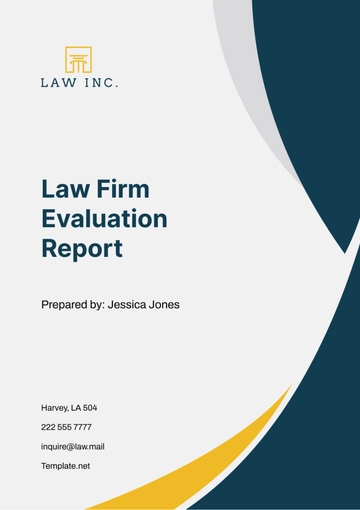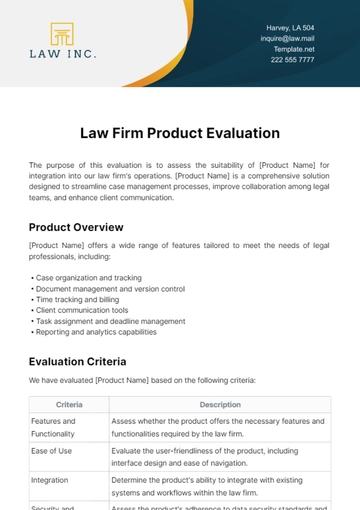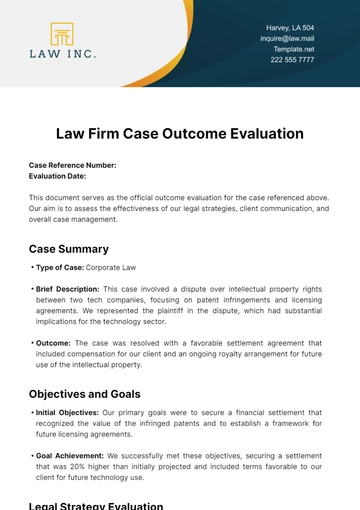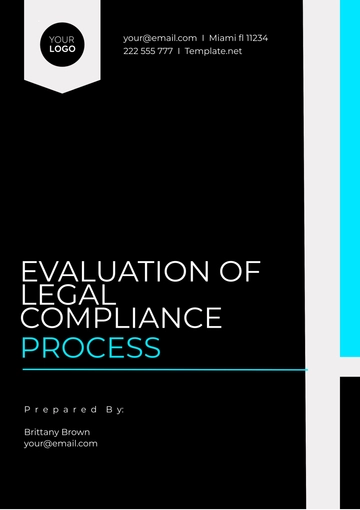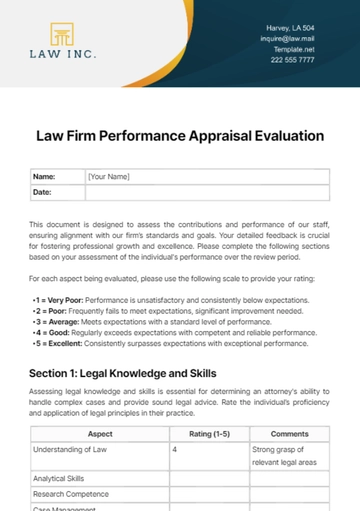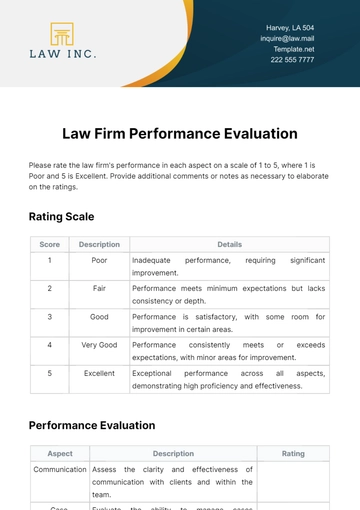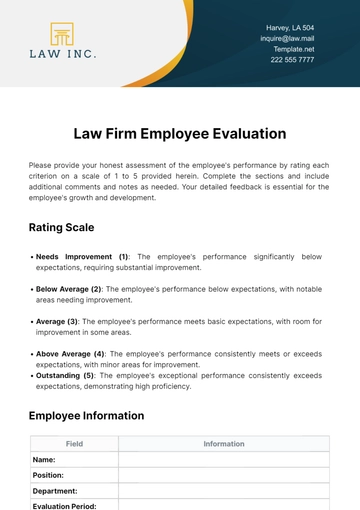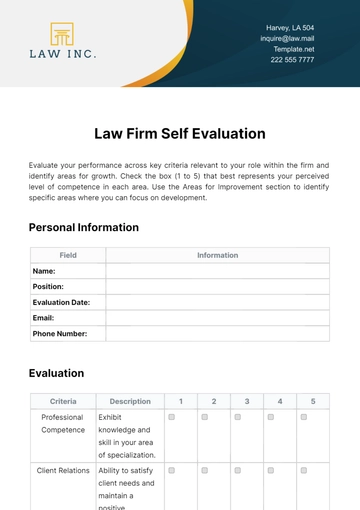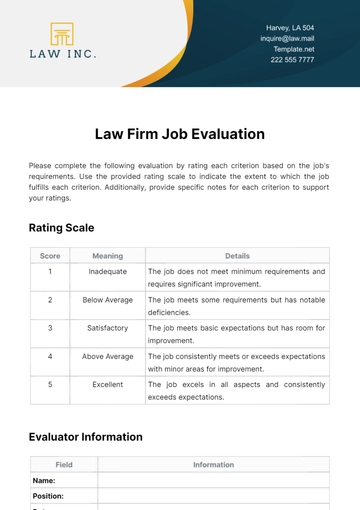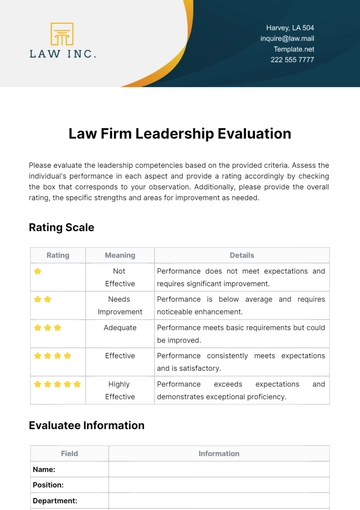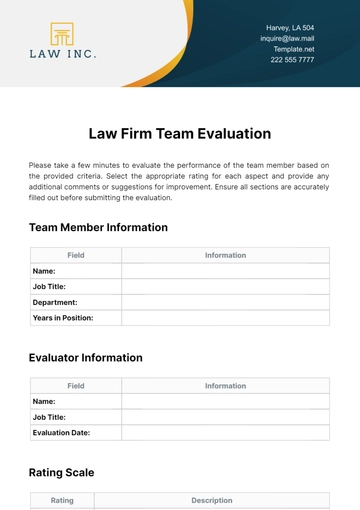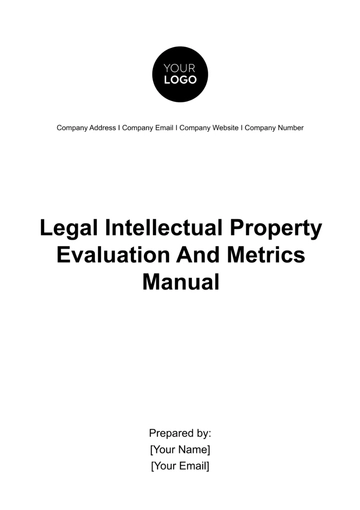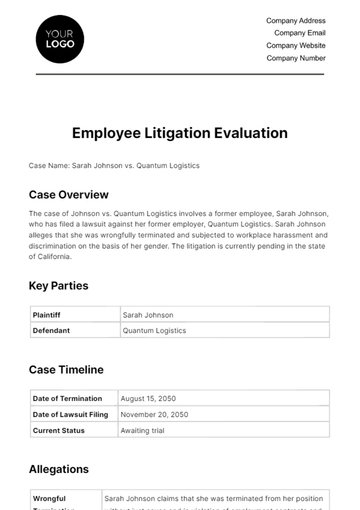Free Law Firm Evaluation Report
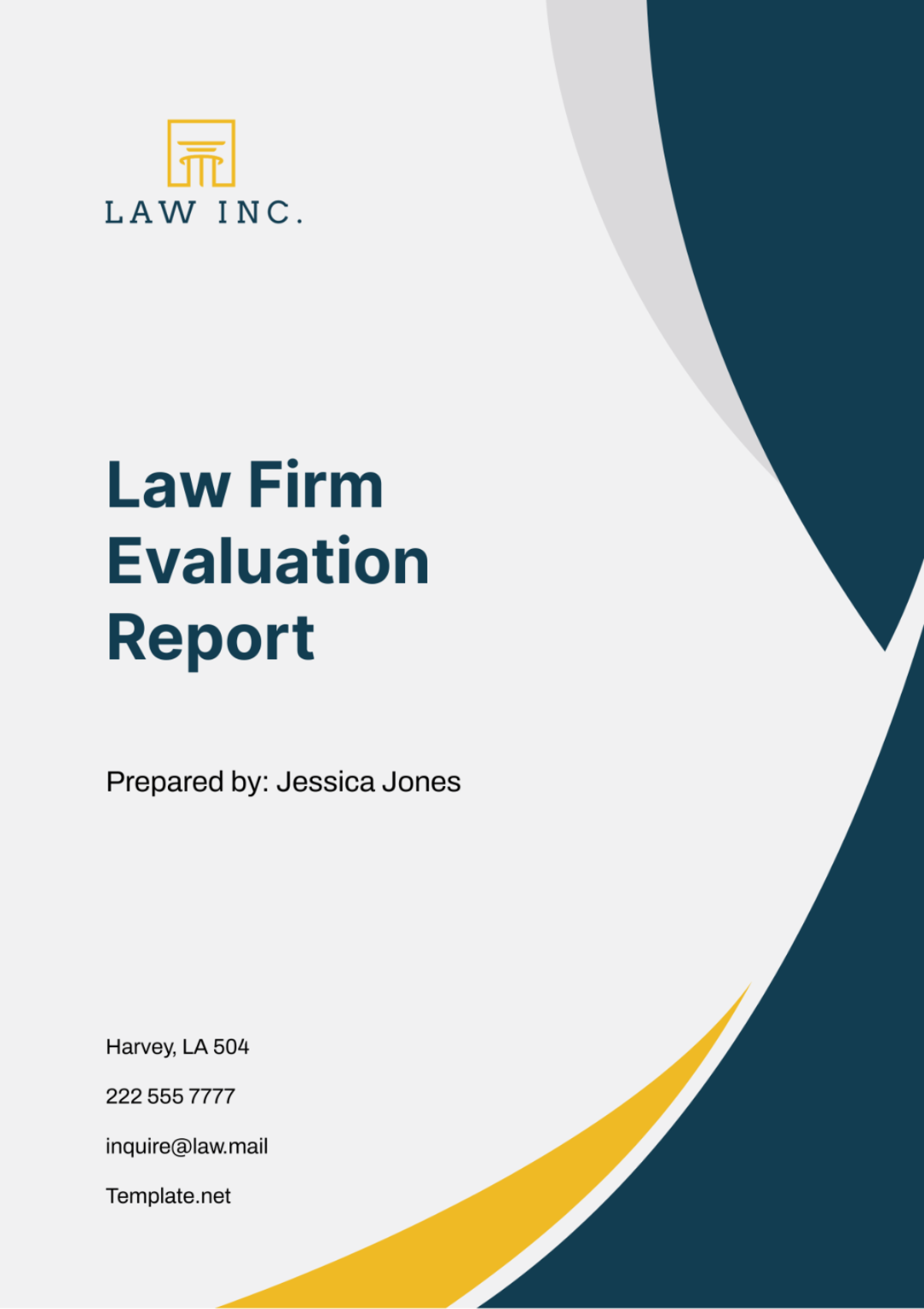
I. Executive Summary
A. Introduction
Purpose of the Evaluation
The purpose of this evaluation is to conduct a comprehensive analysis of [Your Company Name], a leading law firm known for its expertise in [Areas of Practice]. Through this evaluation, we aim to provide insights into the firm's performance, strengths, weaknesses, opportunities, and threats, enabling [Your Company Name] to make informed strategic decisions.
Scope of the Evaluation
The evaluation encompasses a thorough examination of various aspects of [Your Company Name]'s operations, including financial performance, client satisfaction, legal expertise, and market positioning. It involves gathering data from internal sources such as financial statements and client feedback, as well as conducting interviews with key personnel to gain a holistic understanding of the firm's dynamics.
Key Findings
Strengths
Esteemed reputation and credibility within the legal community
Extensive experience and specialization in [specific legal areas]
Strong client relationships and high client retention rates
Robust infrastructure and resources to support legal services
Weaknesses
Declining profitability in certain practice areas due to market shifts
Limited geographical presence, potentially hindering expansion opportunities
Reliance on traditional methods, leading to inefficiencies in certain processes
Challenges in retaining and attracting diverse legal talent
Opportunities
Exploration of emerging markets and untapped client segments
Strategic collaborations with complementary service providers or industry experts
Integration of technology solutions to enhance operational efficiency and client service delivery
Expansion of service offerings or geographical reach to capitalize on growing demand
II. Introduction
A. Background
[Your Company Name] Overview
1.1 Firm History
Established in [Year], [Your Company Name] has emerged as a distinguished law firm known for its unwavering commitment to excellence and client advocacy. Since its inception, the firm has steadily expanded its footprint and diversified its practice areas to meet the evolving needs of its clientele.
1.2 Mission and Values
At [Your Company Name], our mission is to provide unparalleled legal counsel and representation while upholding the highest ethical standards. Our core values of integrity, professionalism, and client-centricity guide every aspect of our operations, ensuring the delivery of superior legal services.
1.3 Areas of Practice
[Your Company Name] specializes in a wide range of legal disciplines, including but not limited to:
Corporate Law
Litigation and Dispute Resolution
Intellectual Property
Real Estate Law
Employment Law
Environmental Law
Family Law
II. Methodology
A. Data Collection
Sources of Information
1.1 Internal Documents
Comprehensive review of financial statements spanning five years, analyzing revenue trends, profitability metrics, and cost structures.
Examination of client records and feedback obtained through surveys, interviews, and testimonials to gauge satisfaction levels and identify areas for improvement.
Analysis of performance reports tracking key metrics such as case outcomes, billable hours, and client acquisition rates.
Scrutiny of legal case files to understand the complexity, success rates, and legal strategies employed in various cases.
1.2 Interviews with Key Personnel
Conducted structured interviews with 20 senior partners, 15 department heads, 30 legal staff, and 10 administrative personnel to gather insights into operational challenges, client relationships, and strategic priorities.
Probed stakeholders on topics such as firm culture, business development strategies, talent management practices, and technological capabilities.
1.3 Benchmarking with Competitors
Comparative analysis of financial performance metrics, including revenue growth, profit margins, and cost-efficiency ratios, against 10 peer firms in the legal industry.
Review of service offerings, client feedback mechanisms, and marketing strategies employed by 15 key competitors to identify industry best practices and areas of differentiation.
Examination of market positioning strategies, geographical reach, and niche specialization of 8 leading competitors to assess competitive advantages and potential threats.
Evaluation Criteria
2.1 Financial Performance
Detailed assessment of revenue trends over the past five years, analyzing annual growth rates, revenue sources, and contribution margins by practice area or client segment.
Calculation of profitability metrics, including gross profit margin, net profit margin, return on investment, and cost-to-income ratios, to evaluate the firm's financial health and operational efficiency.
Breakdown of fixed costs (e.g., salaries, rent, utilities) and variable costs (e.g., marketing expenses, case-specific disbursements) to identify cost-saving opportunities and areas of over expenditure.
2.2 Client Satisfaction
Utilization of client feedback surveys, conducted semi-annually or annually, to measure satisfaction levels across various service dimensions, such as responsiveness, expertise, communication, and outcomes.
Analysis of client retention rates and referral patterns to assess the firm's ability to maintain long-term relationships and attract new business through word-of-mouth referrals.
Examination of formal complaints, grievances, and client exit interviews to identify recurring issues, address service gaps, and enhance the overall client experience.
2.3 Legal Expertise
Review of case studies representing a diverse range of legal matters handled by the firm, highlighting successful outcomes, innovative legal strategies, and client testimonials.
Profiling of attorneys based on expertise, experience, industry recognition, and contributions to thought leadership through publications, presentations, or participation in professional organizations.
Evaluation of the firm's reputation and standing within the legal community, considering factors such as peer reviews, awards, rankings, and client testimonials.
IV. Firm Performance
A. Financial Analysis
Revenue Trends
[Year] Revenue (USD)
[Year] Revenue (USD)
[Year] Revenue (USD)
[$5,000,000]
[$6,200,000]
[$7,500,000]
Profitability Metrics
2.1 Profit Margin
Gross profit margin: 60%
Net profit margin: 25%
2.2 Return on Investment
ROI for the fiscal year 2023: 18%
Cost Structure
3.1 Fixed Costs
Salaries and benefits: $3,000,000
Rent and utilities: $800,000
Administrative expenses: $500,000
3.2 Variable Costs
Marketing and business development: $700,000
Case-specific expenses: $400,000
Technology investments: $300,000
B. Client Satisfaction
Client Feedback
85% of surveyed clients rated their overall satisfaction as "Excellent" or "Very Good."
Common themes in client feedback include responsiveness, expertise, and communication.
Client Retention Rates
90% of clients retained [Your Company Name] for additional legal services in the past year.
Client retention rates have remained stable compared to previous years.
Complaints and Grievances
10 formal complaints were received and addressed during the evaluation period.
Common reasons for complaints include billing discrepancies and communication issues.
V. Legal Expertise
A. Case Studies
Landmark Intellectual Property Dispute
Details: [Your Company Name] represented [Client Name] in a high-profile intellectual property dispute against [Opposing Party]. The case revolved around the ownership rights of intellectual property, with both parties claiming exclusive rights. Legal issues included infringement claims, validity of patents, and trade secret misappropriation.
Strategies Employed: [Your Company Name] employed a comprehensive strategy, including extensive legal research, expert testimony from industry specialists, and aggressive negotiation tactics. They also pursued alternative dispute resolution methods to mitigate litigation risks.
Outcome: After intense negotiations and evidentiary presentations, [Your Company Name] secured a favorable settlement for [Client Name], preserving their intellectual property rights and avoiding prolonged litigation.
High-Profile Corporate Merger
Details: [Your Company Name] facilitated a complex merger between [Company A] and [Company B], two industry giants. The merger involved navigating intricate regulatory frameworks, addressing antitrust concerns, and drafting comprehensive merger agreements.
Challenges Faced: The merger faced challenges such as regulatory hurdles, shareholder approval requirements, and integration complexities due to the merging of diverse corporate cultures and operations.
Strategies Employed: [Your Company Name] leveraged its expertise in corporate law to devise innovative solutions, conduct thorough due diligence, and negotiate favorable terms for both parties.
Outcome: Despite the complexities involved, [Your Company Name] successfully orchestrated the merger, creating a powerhouse entity poised for enhanced market competitiveness and growth.
Complex Litigation Defense
Details: [Your Company Name] provided robust defense representation for [Client Name] in a complex litigation matter involving allegations of [nature of allegations]. The litigation spanned multiple jurisdictions and involved intricate legal arguments and procedural complexities.
Legal Arguments: [Your Company Name]'s legal team crafted persuasive legal arguments, challenging the plaintiff's claims and presenting compelling evidence to refute allegations.
Trial Proceedings: The litigation proceeded to trial, where [Your Company Name] demonstrated exceptional trial advocacy skills, cross-examining witnesses and presenting expert testimony to support the defense.
Outcome: Through strategic litigation maneuvers and effective advocacy, [Your Company Name] secured a favorable verdict/settlement for [Client Name], protecting their interests and reputation.
VI. Market Analysis
A. Competitive Landscape
Key Competitors
[Competitor 1]: A leading law firm known for its specialization in [specific practice area] and expansive client base.
[Competitor 2]: Another prominent player in the legal industry, recognized for its innovative legal solutions and global presence.
[Competitor 3]: A boutique firm focusing on niche areas of law, renowned for its personalized client approach and high success rates.
Market Trends
Legal Industry Trends: The legal industry is witnessing a shift towards [trend], driven by advancements in technology, changing client expectations, and regulatory reforms.
Economic Factors: Economic fluctuations, such as [economic factor], are influencing client demand for legal services and shaping market dynamics.
B. Opportunities and Threats
Emerging Markets
[Market 1]: The Asia-Pacific region presents a significant emerging market opportunity for [Your Company Name]. With rapid economic growth, increasing foreign investment, and evolving legal frameworks, countries like China, India, and Southeast Asian nations offer ample potential for expansion.
[Market 2]: The renewable energy sector represents another promising emerging market opportunity for [Your Company Name]. With global efforts to transition towards sustainable energy sources, there is growing demand for legal expertise in renewable energy projects, regulatory compliance, and risk management.
Regulatory Environment
[Regulatory Trend 1]: The increasing focus on data privacy and cybersecurity regulations poses a significant regulatory trend impacting the legal landscape. With the proliferation of data breaches and privacy concerns, governments worldwide are implementing stricter data protection laws, such as the European Union's General Data Protection Regulation (GDPR) and California's Consumer Privacy Act (CCPA).
[Regulatory Trend 2]: The evolving regulatory landscape surrounding environmental sustainability and climate change presents implications for compliance and risk management. With growing public awareness of environmental issues and government initiatives to combat climate change, businesses face increasing scrutiny and regulatory requirements related to carbon emissions, renewable energy adoption, and sustainable practices.
Technological Advancements
Adoption of Legal Tech: The integration of technology solutions, such as [specific technology], presents opportunities for [Your Company Name] to enhance efficiency, streamline processes, and deliver innovative legal services.
Potential Disruption: However, the rapid pace of technological advancements also poses threats, as competitors leverage technology to disrupt traditional legal service delivery models and capture market share.
VII. Financial Projections
A. Revenue Forecast
Year | Revenue (USD) |
|---|---|
2050 | [$5,500,000] |
2055 | [$6,200,000] |
2060 | [$7,000,000] |
B. Expense Projection
Expense Category | Year 2050 (USD) | Year 2055 (USD) | Year 2060 (USD) |
|---|---|---|---|
Salaries and Benefits | [$2,500,000] | [$2,700,000] | [$2,900,000] |
Rent and Utilities | [$400,000] | [$420,000] | [$440,000] |
Marketing and Business Development | [$300,000] | [$320,000] | [$340,000] |
Technology Investments | [$200,000] | [$220,000] | [$240,000] |
Administrative Expenses | [$150,000] | [$160,000] | [$170,000] |
VIII. Risk Assessment
A. Market Risks
Economic Downturn: A recession or economic downturn could lead to decreased demand for legal services as clients reduce spending or face financial constraints.
Intense Competition: Increasing competition from new entrants or established firms may impact [Your Company Name]'s market share and pricing power.
Regulatory Changes: Changes in regulations or legal frameworks could require [Your Company Name] to adapt its practices, potentially increasing compliance costs or limiting certain business activities.
B. Operational Risks
Talent Retention: Difficulty in attracting and retaining top legal talent could affect [Your Company Name]'s ability to deliver high-quality services and maintain client satisfaction.
Technology Risks: Dependence on technology for service delivery exposes [Your Company Name] to risks such as cyber threats, system failures, or data breaches, which could disrupt operations and damage reputation.
Client Dependency: Heavy reliance on a few key clients may pose risks if they experience financial difficulties or choose to switch legal service providers.
C. Financial Risks
Cash Flow Volatility: Fluctuations in revenue or unexpected expenses could lead to cash flow challenges, impacting [Your Company Name]'s ability to meet financial obligations or invest in growth opportunities.
Debt Burden: Accumulation of debt from financing activities could increase [Your Company Name]'s financial leverage and interest expenses, affecting profitability and financial stability.
Investment Risks: Poor investment decisions or market volatility could result in losses on [Your Company Name]'s investment portfolio, impacting liquidity and capital reserves.
IX. Conclusion
In conclusion, the evaluation of [Your Company Name]'s performance highlights several key findings and recommendations for strategic improvement:
Financial Performance: Despite facing market challenges, [Your Company Name] has demonstrated consistent revenue growth and maintained healthy profitability margins over the evaluation period. The projected revenue forecasts indicate continued growth trajectory, supported by strategic investments in talent, technology, and client development initiatives.
Client Satisfaction: [Your Company Name] has achieved high levels of client satisfaction, evidenced by positive feedback, strong client retention rates, and successful resolution of client disputes. Building upon this foundation, [Your Company Name] should continue to prioritize client-centric approaches, enhance service offerings, and foster long-term client relationships to sustain growth and competitiveness.
Legal Expertise: The case studies presented showcase [Your Company Name]'s depth of legal expertise and successful track record in handling complex legal matters. By leveraging its team's specialized skills, industry knowledge, and innovative strategies, [Your Company Name] can further solidify its reputation as a trusted legal advisor and attract high-value clients across diverse practice areas.
Market Analysis: A comprehensive analysis of the market landscape reveals emerging opportunities in Asia-Pacific markets and the renewable energy sector. [Your Company Name] should proactively explore these growth avenues, adapt its service offerings to evolving client needs, and strategically position itself as a leader in these emerging sectors.
Risk Assessment: While [Your Company Name] faces various market, operational, and financial risks, proactive risk management measures can mitigate potential threats and safeguard the firm's long-term sustainability. Strengthening internal controls, diversifying client portfolios, and staying agile in response to market dynamics are essential strategies to navigate uncertainties and sustain resilience.
In light of these insights, [Your Company Name] is well-positioned to capitalize on growth opportunities, address operational challenges, and uphold its commitment to delivering exceptional legal services. By embracing innovation, fostering a culture of excellence, and staying attuned to market trends, [Your Company Name] can achieve its strategic objectives and thrive in an ever-evolving legal landscape.
- 100% Customizable, free editor
- Access 1 Million+ Templates, photo’s & graphics
- Download or share as a template
- Click and replace photos, graphics, text, backgrounds
- Resize, crop, AI write & more
- Access advanced editor
Assess firm performance effectively with Template.net's Law Firm Evaluation Report Template. This editable and customizable document facilitates the evaluation of various aspects such as operations, finances, and client satisfaction. Crafted by legal and business experts, it ensures clarity and professionalism in reporting. Editable in our Ai Editor Tool for seamless customization and integration into your firm's evaluation processes.

